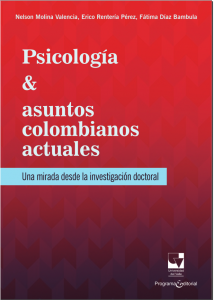Psicología y asuntos colombianos actuales: Una mirada desde la investigación doctoral
Descargas
Alfredsson, L.; Hammar, N.; Fransson, E.; de Paire, U.; Hallqvist, J.; Knutsson, A. y Westerholm, P. (2002). Job strain and major risk factors for coronary heart disease among employed males and females in a Swedish study on work, lipids and fibrinogen. Scand J Work Enviran Health, 28( 4), 238-248.
https://doi.org/10.5271/sjweh.671
Andrea, H.; Bultmann, U.; van Amelsvoort, L. G. P. M. y Kant, Y. (2009). The In cidence of Anxiety and Depression among Employees-the Role of Psychosocial Work Characteristics. Depression and Anxiety, 26( 11), 1040-1048.
https://doi.org/10.1002/da.20516
Berr, C.; Vercambre, M. N.; Bonenfant, S., Manoux, A. S., Zins, M. y Goldberg, M. (2010). Occupational Exposure to Solvents and Cognitive Performance in the GAZEL Cohort: Preliminary Results. Dementia and Geriatric Cognitive Disor ders, 30(1), 12-19. doi: 10.1159/000315498
Chida, Y. y Hamer, M. (2008). Chronic psychosocial factors and acute physiologi cal responses to laboratory-induced stress in healthy populations: a quantitative review of 30 years of investigations. Psychol Bull, 134( 6), 829-885. doi: 10.1037/ a0013342
Choi, B.; Bjorner, J. B.; Ostergren, P. O.; Clays, E.; Houtman, l.; Punnett, L. y Karasek, R. (2009). Cross-language differential ítem functioning of the job con tent questionnaire among European countries: the JACE study. Int J Behav Med, 16(2), 136-147. doi: 10.1007/sl2529-009-9048-2
Cohen, J. (1992). Quantitative Methods in Psychology. Psychological Bulletin, 112(1),155-159.
https://doi.org/10.1037/0033-2909.112.1.155
Crawford, J. R. y Henry, J. D. (2004). The Positive and Negative Affect Schedule (PANAS): Construct validity, measurement properties and normative data in a large non-clinical sample. British Journal of Clínica[ Psychology, 43(3), 245-265. doi: 10.1348/0144665031752934
Dalgard, O. S.; Sorensen, T.; Sandanger, l.; Nygard, J. F.; Svensson, E. y Reas, D. L. (2009). Job demands, job control, and mental health in an 11-year follow-up study: Normal and reversed relationships. Work and Stress, 23(3), 284-296. doi: 10.1080/02678370903250953
Darr, W y Johns, G. (2008). Work Strain, Health, and Absenteeism: A Meta-Anal ysis. Journal of Occupational Health Psychology, 13(4), 293-318. doi: 10.1037/ a0012639
de Lange, A. H.; Taris, T. W.; Kompier, M. A. J.; Houtman, l. L. D. y Bongers, P.
M. (2003). "Toe Very Best of the Millennium": Longitudinal Research and the Demand-Control-(Support) Model. Jaurnal aj Occupatianal Health Psychalogy, 8( 4), 282-305.
https://doi.org/10.1037/1076-8998.8.4.282
Gartner, F. R.; Nieuwenhuijsen, K.; van Dijk, F. J. H. y Sluiter, J. K. (2010). Toe impact of common mental disorders on the work functioning of nurses and allied health professionals: A systematic review. Internatianal Jaurnal aj Nursing Studies, 47(8), 1047-1061. doi: 10.1016/j.ijnurstu.2010.03.013
Gómez, V. y Moreno, L. (2010). Factores Psicosociales del trabajo (demanda-con troly desbalance esfuerzo-recompensa),salud mental y tensión arterial: un estu dio con maestros escolares en Bogotá, Colombia. Universitas Psychalagica, 9(2), 393-407. ISSN 1657-9267
https://doi.org/10.11144/Javeriana.upsy9-2.fptd
Hammar, N.; Alfredsson, L. y Johnson, J. V. (1998). Job strain, social support at work, and incidence of myocardial infarction. Occup Enviran Med, 55(8), 548-553.
https://doi.org/10.1136/oem.55.8.548
Hammar, N.; Alfredsson, L. y Theorell, T. (1994). Job characteristics and the inci dence of myocardial infarction. Int J Epidemial, 23(2), 277-284.
https://doi.org/10.1093/ije/23.2.277
Heponiemi, T.; Kouvonen, A.; Vanska, J.; Halila, H.; Sinervo, T.; Kivimaki, M. y Elovainio, M. (2009). The Association of Distress and Sleeping Problems With Physicians' Intentions To Change Profession: The Moderating Effect ofJob Con trol. Jaurnal aj Occupatianal Health Psychalogy, 14(4), 365-373. doi: 10.1037/ A0015853
Kivimaki, M. (2010). Do pre-employment influences explain the association be tween psychosocial factors at work and coronary heart disease? Toe Whitehall 11 study. Occup Enviran Med, 67(5), 330-334. doi: 10.1136/oem.2009.048470
International Labour Office (ILO), International Programme on Safety and Health at Work and the Environment y ILO International Occupational Safety and Health Information Center (2007a). SajeWark bibliatheque. Geneve: BIT.
Karasek, R. A. J. (1979). Job Demands, job decision latitude and mental strain: Im plications far redesign. Administrative Science Quartely, 24(2), 285-308.
https://doi.org/10.2307/2392498
Kawakami, N. y Tsutsumi, A. (2010). Job Stress and Mental Health among Workers in Asia and the World. Jaurnal aj Occupatianal Health, 52(1), 1-3.
https://doi.org/10.1539/joh.editorial1001
Kayaba, K., Tsutsumi, A., Gotoh, T., Ishikawa, S. y Miura, Y. (2005). Five-year sta bility of job characteristics scale seores among a Japanese working population. J Epidemial, 15(6), 228-234. doi: JST.JSTAGE/jea/15.228
Kim, H. C.; Park, S. G.; Min, K. B. y Yoon, K. J. (2009). Depressive symptoms and self-reported occupational injury in small and medium-sized companies. In ternatianal Archives aj Occupational and Environmental Health, 82( 6), 715-721. doi: 10.1007/s00420-008-0365-6
Kivimaki, M.; Virtanen, M.; Elovainio, M.; Kouvonen, A.; Vaananen, A. y Vahtera,
J. (2006). Work stress in the etiology of coronary heart disease - a meta-analysis.
Scandinavian Journal of Work Environment & Health, 32( 6), 431-442.
Kouvonen, A.; Kivimaki, M.; Cox, S. J.; Cox, T. y Vahtera, J. (2005). Relation ship between work stress and body mass index among 45,810 female and male employees. Psychosomatic Medicine, 67(4), 577-583. doi: 10.1097/01.psy. 0000170330.08704.62
Kudielka, B. M.; Van Kanel, R.; Gander, M. L. y Fischer, J. E. (2004). Effort-re ward imbalance, overcommitment and sleep in a working population. Work and Stress, 18(2), 167-178. doi: 10.1080/02678370410001731785
Marchand, A. y Blanc, M. E. (2010). The Contribution of Work and Non-work Factors to the Onset of Psychological Distress: An Eight-year Prospective Study of a Representative Sample of Employees in Canada. Journal of Occupational Health, 52(3), 30-39.
Mendis, S.; Puska, P.; Norrving, B.; World Health Organization; World Heart Fed eration y World Stroke Organization (2011). Global atlas on cardiovascular dis ease prevention and control. Geneva: World Health Organization.
Ready, R. E.; Vaidya, J. G.; Watson, D.; Latzman, R. D.; Koffel, E. A. y Clark, L. A. (2011). Age-group differences in facets of positive and negative affect. Aging Ment Health, 15(6), 784-795. doi: 10.1080/13607863.2011.562184
Sandoval, C. y Unda, S. (2010). Síndrome de Burnout en profesores de un instituto politécnico UNAM-México. Paper presented at the Foro para las Américas sobre Factores Psicosociales en el Trabajo, México.
Shultz, K. S.; Wang, M.; Crimmins, E.M. y Fisher, G. G. (2010). Age Differences in the Demand-Control Model of Work Stress An Examination of Data From
https://doi.org/10.1177/0733464809334286
European Countries. Journal of Applied Gerontology, 29(1), 21-47. doi: 10.1177/0733464809334286
Siegrist, J.; Wege, N.; Puhlhofer, F. y Wahrendorf, M. (2009). A short generic measure of work stress in the era of globalization: effort-reward imbalance. International Archives of Occupational and Environmental Health, 82(8), 1005- 1013. doi: 10.1007/s00420-008-0384-3
Smith, L. A.; Roman, A.; Dollard, M. F.; Winefield, A. H. y Siegrist, J. (2005). Effort-reward imbalance at work: the effects of work stress on anger and car diovascular disease symptoms in a community sample. Stress and Health, 21(2), 113-128. doi: 10.1002/smi.1045
Steptoe, A.; Hamer, M. y Chida, Y. (2007). The effects of acute psychological stress on circulating inflammatory factors in humans: A review and meta-analysis. Brain, Behavior, and Immunity, 21(7), 901-912. doi: 10.1016/j.bbi.2007.03.011
Thomas, C. y Power, C. (2010). Do early life exposures explain associations in mid-adulthood between workplace factors and risk factors for cardiovascular disease? Int J Epidemial, 39(3), 812-824. doi: 10.1093/ije/dyp365
Unda, S. (2010). Foro de las Américas sobre Factores Psicosociales en el Trabajo. Mé xico.
Valverde Pérez, M. (2007). Radiografía de los riesgos psicosociales. Gestión prácti ca de riesgos laborales: Integración y desarrollo de la gestión de la prevención, 34, 32-35.
Van Vegchel, N.; de Jonge, J.; Bosma, H. y Schaufeli, W. (2005). Reviewing the ef fort-reward imbalance model: drawing up the balance of 45 empirical studies.So cial Science & Medicine, 60(5), 1117-1131. doi: 10.1016/j.socscimed.2004.06.043
Van Vegchel, N., De Jonge, J. y Landsbergis, P. A. (2005). Occupational stress in (inter)action: the interplay between job demands and job resources. Journal of Organizational Behavior, 26(5), 535-560. doi: 10.1002/job.327
Vieco, G. y Gómez, B. (2006). Burnout y factores psicosociales en profesores con altos ingresos de un colegio perteneciente a una empresa multinacional. Montelíbano, Córdoba, Colombia, 2006. (Tesis de Especialización Salud Ocupacional). Uni versidad de Antioquia, Medellín.
Vieco, G. y Mazuera del Hierro, M. (2004). Violencia en el trabajo en Colombia (G. Vieco (Ed.). Medellín, COL: LVieco.
Vieco, G.; Soracá, A. l. y Yepes, M. B. (2006). Factores Psicosociales de origen laboral en el trabajo docente en una muestra de 460 profesores de la etnia Zenú en cole gios estatales. Departamento de Córdoba, Colombia. (Tesis de Especialización en Salud Ocupacional Investigación Social en Salud). Universidad de Antioquia, Medellín, Colombia.
Vieco, G. F. y Gómez, G.A. (2009). Factores de Riesgo Psicosocial y Burnout en médicos del programa de Salud Familiar de la EPS-COMFAMA. Medellín. (Tesis de Maes tría en Salud Ocupacional). Universidad de Antioquia, Medellín, Colombia.
Wang, J. L.; Schmitz, N.; Dewa, C. y Stansfeld, S. (2009). Changes in Perceived Job Strain and the Risk of Major Depression: Results From a Population-based Longitudinal Study. American Journal of Epidemiology, 169(9), 1085-1091. doi: 10.1093/Aje/Kwp037
Xu, W. X.; Zhao, Y. M.; Guo, L. J.; Guo, Y. H. y Gao, W. (2010). Toe Association Between Effort-Reward Imbalance and Coronary Atherosclerosis in a Chinese Sample. American Journal of Industrial Medicine, 53(7), 655-661. doi: 10.1002/ ajim.20818
Yang, X.; Ge, C.; Hu, B.; Chi, T. y Wang, L. (2009). Relationship between quality of life and occupational stress among teachers. Public Health, 123(11), 750-755. doi: 10.1016/j.puhe.2009.09.018


Esta obra está bajo una licencia internacional Creative Commons Atribución-CompartirIgual 4.0.



